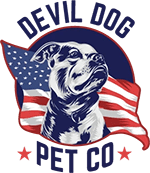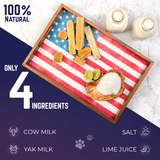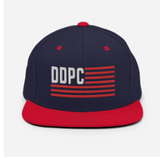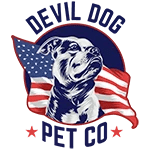Key Takeaways
- Bulk dog treats are premium chews and snacks sold in large quantities.
- They typically come in cases weighing 1-25+ pounds or packs containing 50-200 pieces.
- Purchasing bulk dog treats means investing in months of supply at once.
- Buying in bulk often involves wholesale vendor sizing rather than individual packages.
Table of Contents
- What Are Bulk Dog Treats, and Why Should You Care?
- Key Benefits of Buying Bulk Dog Treats (Backed by Science & Real-World Experience)
- Types of Bulk Dog Treats Available, and How to Choose the Right One
- Natural vs. Artificial Ingredients in Bulk Dog Treats, Why It Matters for Your Dog's Health
- Bulk Dog Treats vs. Individually Packaged, Cost, Freshness, and Convenience Compared
- How to Store and Keep Bulk Dog Treats Fresh, Pro Techniques for Every Treat Type
- How to Portion, Serve, and Rotate Bulk Dog Treats Safely
- Transitioning to New Bulk Dog Treats, A Step-by-Step Guide
- Eco-Friendly & Ethical Bulk Dog Treats, Supporting the Mission While You Shop
- Common Pitfalls and Solutions When Buying Bulk Dog Treats
- Best Bulk Dog Treats by Use Case, Extreme Dog Leadership Top Picks
- Call to Action, Stepping Up as a Responsible Leader with Bulk Dog Treats
What Are Bulk Dog Treats, and Why Should You Care?
Bulk dog treats are premium chews and snacks sold in large quantities, typically 1-25+ pound cases, multi-count packs of 50-200 pieces, or wholesale vendor sizing. Instead of grabbing individual packages off the shelf, you're investing in months of supply at once. Large Himalayan Dog Chews are a popular example of a bulk treat that provides long-lasting enjoyment for dogs.
Smart dog owners choose bulk for four mission-critical reasons: cost savings up to 40% per treat, reduced packaging waste, guaranteed supply for intensive training programs, and the ability to support shelter dogs through volume purchasing power. For Nancy managing her first rescue's anxiety-chewing phase, bulk means never running out of redirection tools. For Becky's three-dog household, it's the difference between spending $200 monthly on individual bully sticks versus $120 for the same quantity in bulk cases. Yak cheese chews are especially favored for their durability and single-ingredient simplicity.
For those interested in the health benefits of single-ingredient options, single ingredient dog treats offer a comprehensive guide to healthy snacking and can help you make informed choices when buying in bulk.
Bulk vs. Individual Packaging: At a Glance
- Cost per treat: Bulk saves 25-45% per ounce
- Shelf life: Same as individual when stored properly
- Convenience: Bulk requires upfront storage planning
- Environmental impact: 60-80% less packaging waste per pound
Download the FREE 10-Step Dog Prep Guide
Key Benefits of Buying Bulk Dog Treats (Backed by Science & Real-World Experience)

The math is undeniable. A single 6-inch bully stick costs $3.50 retail but drops to $1.40 when purchased in 50-count cases, that's $2.10 savings per stick. For power-chewer households using 2-3 weekly, bulk purchasing saves $327 annually on bully sticks alone.
Beyond economics, bulk buying ensures consistent training success. Behavioral research shows that intermittent reinforcement schedules work best when high-value rewards are always available. Running out of premium chews mid-training session forces owners to substitute inferior treats, weakening command reliability. Our dog Dexter's place-training breakthrough happened because we never missed a reward opportunity, bulk yak chews kept his motivation peaked for six straight weeks. For more on the benefits of yak chews, read about healthy yak chews for dogs and why they're a top pick for training and enrichment.
Environmental impact matters too. The EPA estimates that bulk packaging reduces plastic waste by 3.2 pounds per household annually compared to individual treat purchasing. Fewer delivery trucks, consolidated shipping, and recyclable bulk containers multiply the eco-benefits. Every bulk order supports the mission: fewer resources wasted, more dollars directed toward quality ingredients and shelter support programs.
Types of Bulk Dog Treats Available, and How to Choose the Right One
Premium bulk dog treats span the spectrum: single-ingredient powerhouses like elk antlers and yak chews, protein-rich bully sticks and beef trachea, plus softer training treats and freeze-dried options. Each serves distinct behavioral and nutritional needs.
Power chewers thrive on bulk antler cases, whole elk antlers provide 4-8 weeks of gnawing per piece, making 10-antler cases cost-effective for aggressive chewing styles. Sensitive stomachs benefit from single-ingredient bulk yak chews, which eliminate common allergens while delivering long-lasting entertainment. Training-intensive households need mini dog treats in bulk, freeze-dried liver, small bully stick pieces, or soft training rewards that won't derail daily calorie targets.
Selection strategy matters. A customer's German Shepherd with chicken allergies switched from mixed jerky treats to pure yak chew cases, zero digestive flare-ups and 40% cost savings. Match treat hardness to dental health: seniors get softer bulk options like split antlers, while teething puppies need appropriately sized pieces from bulk bully stick cases.
| Dog Profile | Best Bulk Treat Type | Typical Case Size | Duration per Case |
|---|---|---|---|
| Power Chewer (50+ lbs) | Whole Elk Antlers | 10-piece case | 10-20 weeks |
| Multi-dog Household | Bully Stick Variety Pack | 50-100 pieces | 6-12 weeks |
| Training Focus | Mini Training Treats | 2-5 lb bags | 4-8 weeks |
| Allergy-Sensitive | Single-Ingredient Yak Chews | 20-30 piece case | 8-16 weeks |
Natural vs. Artificial Ingredients in Bulk Dog Treats, Why It Matters for Your Dog's Health
"Natural" on bulk treat labels means ingredients derived from plant, animal, or mineral sources without synthetic processing, but marketing teams stretch this definition. True single-ingredient treats list one item: "beef pizzle" or "elk antler" or "yak milk." Multi-ingredient treats demand scrutiny.
Red flags in bulk dog biscuits wholesale include artificial colors (Blue 2, Red 40), propylene glycol, corn syrup, and rendered by-products. These additives can trigger allergies, digestive upset, and long-term health issues. Always read the ingredient list, if you can't pronounce it, your dog doesn't need it. Stick to bulk treats with transparent sourcing and minimal processing for optimal health and safety.
Bulk Dog Treats vs. Individually Packaged, Cost, Freshness, and Convenience Compared

The economics speak clearly: bulk dog treats deliver 30-50% cost savings per ounce compared to individual packaging. A 5-lb case of bully sticks averages $0.85 per stick versus $1.40 for single-pack purchases. For multi-dog households like Becky's, this translates to $400+ annual savings on chews alone.
Freshness becomes the trade-off. Individually wrapped treats maintain peak quality until opened, while bulk purchases expose entire quantities to air and moisture once unsealed. However, proper storage negates this disadvantage, airtight containers preserve bulk yak chews for 18+ months, matching sealed individual packages.
| Factor | Bulk Dog Treats | Individual Packages |
|---|---|---|
| Cost per ounce | 30-50% lower | Premium pricing |
| Training convenience | Always stocked | Frequent reordering |
| Storage requirement | Dedicated containers needed | Shelf-stable as-is |
| Freshness control | Owner-managed | Factory-sealed |
| Waste reduction | 85% less packaging | Individual wrappers |
Convenience favors bulk for established routines. Nancy's single-dog apartment setup might prefer individual packaging for variety and space constraints, while Becky's three-dog household benefits from bulk reliability and economics.
How to Store and Keep Bulk Dog Treats Fresh, Pro Techniques for Every Treat Type
Temperature and humidity destroy more bulk treats than expiration dates. The 70/70 rule applies: store below 70°F with less than 70% humidity to prevent mold and rancidity. Most owners fail by using the original bulk packaging, those thin plastic bags offer zero moisture protection.
Hard chews like antlers and yak sticks require breathable storage. Food-grade mesh bags or perforated containers prevent condensation while maintaining airflow. Soft treats demand airtight sealing within 30 minutes of opening, vacuum-sealed glass jars extend shelf life by 6+ months compared to loose storage.
Rotation prevents waste and staleness. Label containers with purchase dates and follow first-in, first-out inventory. Freeze portions of soft treats in weekly servings, frozen jerky treats thaw in 10 minutes while maintaining original texture and nutrition. For more tips on healthy treat storage and selection, see our top 10 healthy dog treats recommendations.
Storage Lifespans by Treat Type:
• Elk antlers: 2+ years in dry conditions
• Yak chews: 18 months in breathable containers
• Bully sticks: 12 months airtight, 36 months unopened
• Soft training treats: 3-6 months refrigerated after opening
Monitor for spoilage weekly. Discard any treats showing white fuzzy mold, strong ammonia odors, or slimy textures. When stored correctly, quality bulk treats maintain nutritional value and palatability throughout their recommended shelf life.
How to Portion, Serve, and Rotate Bulk Dog Treats Safely
The 10% rule governs safe treat portioning: no more than 10% of daily calories should come from treats. A 50-lb dog consuming 1,200 calories daily can handle 120 treat calories, roughly one standard bully stick or half a large yak chew. Exceeding this threshold risks nutritional imbalance and weight gain.
Serving size depends on purpose. Training sessions require pea-sized pieces to maintain focus without satiation. Crate time calls for longer-lasting chews sized larger than the dog's muzzle width to prevent choking. Always supervise initial sessions with new bulk treats to gauge chewing style and pace. For additional safety guidelines, refer to the AVMA's safe handling of pet food and treats.
Protein rotation prevents food sensitivities and maintains interest. Alternate between beef (bully sticks), elk (antlers), and yak milk proteins weekly. This approach reduces allergen exposure while providing varied textures and flavors. Dexter thrives on a Monday-Wednesday-Friday elk antler, Tuesday-Thursday yak chew rotation.
Introduce new bulk dog treats gradually over 3-5 days. Start with quarter portions after meals to minimize digestive upset. Watch for loose stools, excessive gas, or skin irritation, signs to slow the transition or eliminate the new protein entirely.
Transitioning to New Bulk Dog Treats, A Step-by-Step Guide

Successful transitions prevent digestive upset and treat rejection. Start new bulk treats after regular meals when dogs feel satisfied but not stuffed. This timing reduces gorging behavior and allows gradual stomach adaptation to new proteins.
Day 1-2: Offer thumbnail-sized pieces for 5-10 minutes maximum. Remove uneaten portions to maintain novelty. Day 3-4: Increase to normal serving size if no digestive issues appear. Day 5-7: Full integration into rotation schedule.
Monitor stool consistency, energy levels, and skin condition throughout the transition. Loose stools, vomiting, or lethargy signal the need to slow down or revert to previous treats. When in doubt, consult your veterinarian for guidance on introducing new proteins or treat types.
Eco-Friendly & Ethical Bulk Dog Treats, Supporting the Mission While You Shop
Your purchasing power drives industry change. Choosing ethical bulk dog treats reduces packaging waste by up to 75% compared to individual wrapping while supporting sustainable sourcing practices.
Look for naturally shed antlers, elk drop their racks annually without human intervention. Fair-trade yak chews from Himalayan cooperatives support traditional livelihoods. USDA-certified beef pizzles from grass-fed cattle minimize environmental impact while maintaining quality standards. For more information on the benefits of yak cheese chews, check out this article on natural yak cheese chew treats for dogs.
Impact Math: A 5-pound bulk order generates 60% fewer shipping emissions than five separate 1-pound deliveries. Recyclable packaging multiplies the environmental benefit.
Ask these questions before buying: Are chews naturally shed or ethically harvested? Does packaging use recycled materials? Does the company donate to shelters or veteran causes? Mission-driven brands like Devil Dog Pet Co. channel profits toward service dog programs and rescue support, your treat purchase becomes community investment.
Common Pitfalls and Solutions When Buying Bulk Dog Treats
Bulk buying amplifies both successes and mistakes. Address these common problems before they derail your investment:
Spoilage and Storage Failure: Soft treats develop mold within 48 hours if stored improperly. Check for white spots, sour odors, or texture changes weekly. Store opened packages in airtight containers with desiccant packets.
Dog Boredom and Refusal: Offering the same treat daily kills motivation. Rotate between protein sources weekly, yak chews Monday-Wednesday, bully sticks Thursday-Friday, antlers weekends. Freeze treats between sessions to maintain novelty.
Digestive Upset from Overfeeding: Rich treats like marrow-filled bones can cause loose stools if consumed rapidly. Limit initial sessions to 15 minutes, gradually extending as tolerance builds. For more on pet food safety, see the FDA's FAQ about pet food.
| Problem | Quick Fix | Prevention |
|---|---|---|
| Mold growth | Discard immediately, sanitize storage container | Moisture-proof containers, weekly inspections |
| Treat refusal | Add peanut butter coating, warm slightly | Rotate flavors, limit access time |
| Overstock | Donate to local shelter, freeze extras | Calculate monthly usage before ordering |
Best Bulk Dog Treats by Use Case, Extreme Dog Leadership Top Picks

Match your bulk purchase to specific leadership goals:
Dogs with Allergies/Sensitivities
Best choice: Single-ingredient elk antlers or yak chews. Zero additives, preservatives, or common allergens. Devil Dog Pet Co.'s Grade-A antlers contain only naturally shed elk bone, no processing chemicals or cross-contamination risk. For more on antler safety, read are antlers for dogs a good idea.
Multi-Dog/Working Dog Homes
Best choice: Mixed variety packs of different hardness levels. Rotate between soft training treats for commands and durable chews for independent enrichment. Bulk bully stick assortments provide protein variety while maintaining consistent quality.
Training Sessions
Best choice: Mini soft treats in 2-pound containers. Pea-sized portions deliver instant rewards without disrupting meal schedules. Look for freeze-dried single proteins that won't crumble in treat pouches. For a great option, consider freeze dried chicken dog treats for training rewards.
Eco-Minded/Mission-Driven Households
Best choice: Naturally sourced chews from veteran-owned companies. Devil Dog Pet Co. combines sustainable elk shed harvesting with direct shelter support, every purchase funds service dog programs for veterans.
Call to Action, Stepping Up as a Responsible Leader with Bulk Dog Treats
Extreme Dog Leadership means making intentional choices that serve your dog's long-term wellbeing. Bulk dog treats aren't just about saving money, they're about creating consistent enrichment routines that prevent behavioral problems before they start.
Your four-step action plan:
- Choose Right: Match treat hardness to your dog's chewing style and dietary needs
- Store Smart: Invest in proper containers and rotation systems
- Portion Precisely: Limit treats to 10% of daily calories, measure portions
- Monitor Results: Track dental health, behavior changes, and digestive response
Every bulk purchase is a leadership decision. Choose brands that align with your values, sustainable sourcing, veteran support, and transparent quality standards. When you invest in premium bulk treats, you're not just feeding your dog, you're building the foundation for a thriving partnership that keeps dogs out of shelters and in loving homes where they belong.
Take command. Your dog's success starts with your commitment to excellence.
Download the FREE 10-Step Dog Prep Guide
Frequently Asked Questions
What are the main advantages of buying bulk dog treats compared to individually packaged ones?
Buying bulk dog treats saves you 25-45% per ounce, reduces packaging waste by up to 80%, and ensures you have a steady supply for training or multi-dog households. It’s a smart investment in cost, convenience, and environmental impact when you plan for proper storage.
How can I properly store bulk dog treats to maintain their freshness and nutritional value over time?
Store bulk treats in airtight containers away from heat, moisture, and direct sunlight. Use cool, dry spaces like pantries or refrigerators for perishable items, and rotate stock to use older treats first, this preserves flavor, texture, and nutrients.
What types of bulk dog treats are best suited for intensive training programs or power-chewer households?
Durable, single-ingredient chews like yak cheese sticks, whole elk antlers, and jumbo bully sticks stand up to heavy chewing and provide long-lasting rewards. These treats offer mental stimulation and endurance needed for frequent training or tough chewers.
Why is choosing natural or single-ingredient bulk dog treats important for my dog's health?
Natural, single-ingredient treats minimize exposure to additives, preservatives, and fillers that can upset digestion or trigger allergies. They support dental health, reduce anxiety, and align with responsible leadership by fueling your dog with safe, wholesome nutrition.






